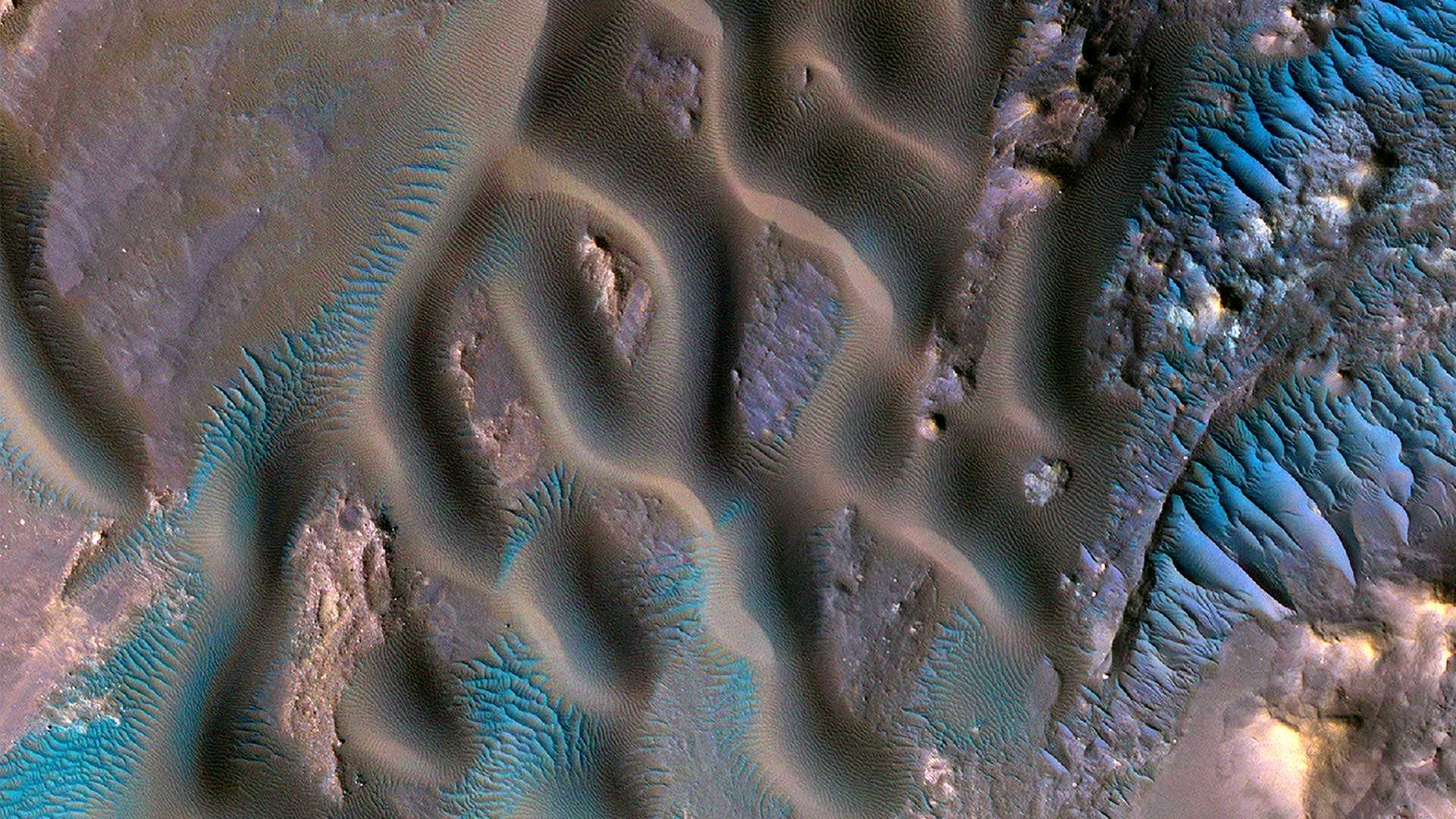甘博阿陨击坑,火星 Gamboa Crater, Mars (© NASA/JPL-Caltech/University of Arizona)

甘博阿陨击坑,火星 Gamboa Crater, Mars (© NASA/JPL-Caltech/University of Arizona)
此景只应天上有 Out of this world
甘博阿陨击坑,火星
在火星上生存相当艰难,天气极寒、干燥,而且条件恶劣。火星上的平均温度约为零下62摄氏度,两极的温度甚至可能低至零下152摄氏度。但这颗行星上有许多峡谷、死火山和冰盖,远观还是很美的。火星勘测轨道飞行器发回的大多数照片都显示火星是一颗红色星球,这是因为火星表面有大量红色的赤铁矿,所以呈现橘红色。
这张照片展示的是甘博阿陨击坑,但这并非甘博阿陨击坑的真实颜色。科学家们对这张照片进行了校色,视觉效果更直观,更便于科学分析。
Gamboa Crater, Mars
It would be pretty tough to live on Mars. It's cold, dry, and the conditions are harsh. The planet's average temperature is about –81 degrees Fahrenheit, but it can get as low as –243 at the poles. But with many canyons, extinct volcanoes, and ice caps, it's beautiful to look at from afar. Most photos of the Red Planet highlight its rusty color, caused by high levels of iron oxide.
This photo shows us Mars' Gamboa Crater, but not with accurate colors. Scientists have recolored the wavelengths that our eyes can't see on their own. These added details let us see the effects of wind inside the crater, providing a perfect example of the spectacularly complex features of this planet.
火星 Mars (© NASA/Alamy)

太阳系的第四颗行星 Fourth rock from the sun
红色星球日
距离地球约1.4亿英里,是太阳系中最相关的行星,围绕太阳运行。火星,俗称红色行星,是仅次于水星、金星和地球的第四颗太阳行星。除了我们自己的星球之外,我们对火星的了解比任何其他星球都多。这方面的知识已经积累了几个世纪,近年来随着好奇号和毅力号火星探测器分别于2012年和2021成功登陆火星,这一知识以指数级增长。今天,我们在红色星球日庆祝这些成就和其他成就,这一天恰逢1964年的这一天,第一艘火星探测器“水手4号”发射升空。
火星在古代被观测到是夜空中一个明亮而移动的物体,与恒星不同。甚至用肉眼观察到它的红色。我们的好奇心根深蒂固。它可能不是最接近我们的行星金星拥有这个称号,但它似乎是最吸引我们想象力的行星。我们了解的越多,我们就越能想象火星在很久以前可能和地球一样,拥有有机生命、河流和海洋,以及比今天更厚的大气层。与其他行星相比,火星目前的条件虽然不完全适合居住,但却非常适宜居住,这也许是我们倾向于想象在这颗红色星球上生活可能有一天的最令人信服的原因。
Red Planet Day
About 140 million miles away from Earth, the most relatable planet in the solar system orbits the sun. Mars, popularly known as the Red Planet, is the fourth planet from the sun, after Mercury, Venus, and Earth. We know more about Mars than any other planet but our own. That knowledge has been gained over centuries and has grown exponentially in recent years with the successful landings on Mars of the Curiosity and Perseverance rovers in 2012 and 2021 respectively. Today we celebrate those and other accomplishments on Red Planet Day, which coincides with the launch of Mariner 4, the first probe sent to Mars, on this day in 1964.
Mars was observed in ancient times as a bright and moving object in the night sky, distinct from the stars. Even its reddish tint was observed by the naked eye. Our curiosity was cemented. It might not be the planet closest to ours—Venus owns that title—but it seems to be the planet that most captures our imagination. The more we learn, the more we can imagine that Mars might have been just like Earth a long time ago, possessing organic life, rivers and oceans, and a much thicker atmosphere than it does today. Current conditions on Mars, while not exactly habitable, are hospitable by comparison to those on other planets, maybe the most compelling reason we're inclined to imagine that living on the Red Planet might someday be possible.
火星快车号传来的火星南极冰盖图像 Mars Express image of the icy cap at Mars’ south pole (© ESA/DLR/FU Berlin/Bill Dunford)

火星快车号传来的火星南极冰盖图像 Mars Express image of the icy cap at Mars’ south pole (© ESA/DLR/FU Berlin/Bill Dunford)
An ice cap-puccino
No, that's not a new frozen coffee drink from Starbucks; it's the southern polar ice cap on Mars. Mars is the only other planet in the Solar System with a visible ice cap, though it differs from Earth’s because it is comprised of both water ice and frozen carbon dioxide. The ice cap looks smooth here, but its surface is pockmarked with swiss cheese-like depressions caused by the seasonal freezing and melting of the Martian winters and summers. While Mars has been observed by humanity for thousands of years, it was only on August 13, 1642, that Dutch astronomer Christiaan Huygens observed the ice cap using the most powerful telescope of the day. The giant of science designed the 50x magnification telescope himself, and with his brother, produced the lenses as well.